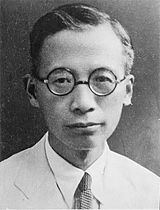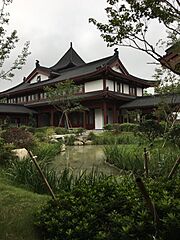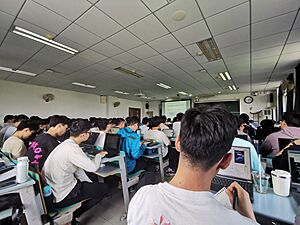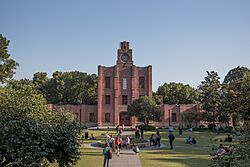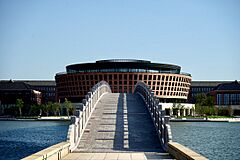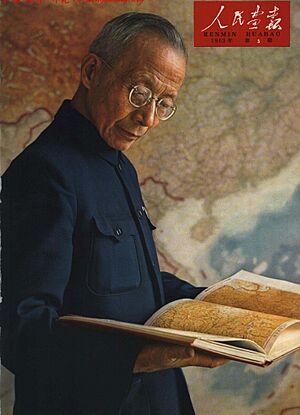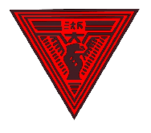Zhejiang University facts for kids
|
浙江大学
|
|||||||
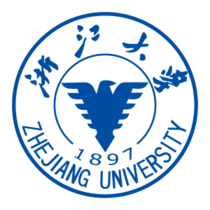 |
|||||||
|
Other name
|
ZJU or Zheda | ||||||
|---|---|---|---|---|---|---|---|
|
Former name
|
Chekiang University (1902–1903) Chekiang Higher Institutes (1903–1914) National Third Chungshan University (1927–1928) Chekiang University (1928) National Chekiang University (1928–1950) Chekiang University (1950 – mid-1980s) |
||||||
| Motto | 求是创新 | ||||||
|
Motto in English
|
Seeking Truth and Pursuing Innovation | ||||||
| Type | Public | ||||||
| Established | 1897. Reformed as university in 1928. | ||||||
|
Academic affiliations
|
C9, APRU, IAU, GUNi, YDUA, BRICS Universities League | ||||||
| Budget | CN¥ 26.1 billion (2022) | ||||||
| President | Du Jiangfeng | ||||||
| Party Secretary | Ren Shaobo | ||||||
|
Academic staff
|
4,557 | ||||||
| Students | 65,821 | ||||||
| Undergraduates | 29,117 | ||||||
| Postgraduates | 36,704 | ||||||
| Location |
,
China
30°15′49″N 120°07′15″E / 30.26361°N 120.12083°E |
||||||
| Campus | 622 hectares (1,540 acres) | ||||||
| Academic term | Semester | ||||||
| Colors | Blue | ||||||
| Mascot | Qiushi Eagle 求是鹰 | ||||||
| Website | (in Chinese) zju.edu.cn (in English) zju.edu.cn/english |
||||||
 |
|||||||
| Chinese name | |||||||
| Simplified Chinese | 浙江大学 | ||||||
| Traditional Chinese | 浙江大學 | ||||||
| Postal | Chekiang University | ||||||
|
|||||||
Zhejiang University (ZJU), also known as Zheda, is a large public university in Hangzhou, Zhejiang, China. It is supported by the Ministry of Education. ZJU is part of special national plans like Double First-Class Construction, Project 985, and Project 211. These plans help make it one of China's top universities.
The university started as National Third Chungshan University in 1927. It was soon renamed National Chekiang University (NCKU) in 1928. During the time of President Chu Kochen (1936-1949), the university moved to Guizhou in West China because of the Sino-Japanese War. It moved back to Hangzhou in 1946.
In 1952, the university was reorganized to focus mainly on engineering. Later, in 1998, several other universities joined with Zhejiang University. These included Zhejiang Medical University, Hangzhou University, and Zhejiang Agricultural University. This merger made ZJU a complete university with many different subjects.
Today, Zhejiang University has 7 main faculties and 37 colleges, schools, and departments. It offers over 140 programs for undergraduate students and 300 programs for graduate students. The university also has seven hospitals, one museum, and over 200 student clubs. Many of its teachers are top experts in science and engineering in China. ZJU is also a member of the C9 League, a group of the best universities in China.
Contents
History of Zhejiang University
Early Years: 1897–1914
Zhejiang University began as Qiushi Academy in 1897. The mayor of Hangzhou, Lin Qi, started it. Because of education changes in China, the academy was renamed Chekiang University in 1902. Then it became Chekiang Higher Institute in 1903. This institute was the first in its province to send students to study in other countries. However, the institute closed in 1914 due to new government plans.
Becoming a National University: 1928–1949
After the Chekiang Higher Institute closed, it was hard to reopen it because of fighting between different groups. In 1927, the National Third Chungshan University was created in Hangzhou. It combined Chekiang Industrial College and Chekiang Agricultural College. On April 1, 1928, it was renamed Chekiang University. Later that year, it became National Chekiang University (NCKU). Jiang Menglin, a former student and teacher, became its first president.
In 1929, Shao Peizi became president. He had some disagreements with the government, which led to funding problems. In 1932, Shao resigned. Cheng Tien-fong, a government member, then became the new president. With help from Chiang Kai-shek, the university started getting money directly from the central government.
In 1933, Kuo Zing-Yang became president. But as the war with Japan grew, students protested against the government. In 1935, students removed Kuo from his position.
Chu Kochen, a respected scholar, became president of NCKU in 1936. He brought many top scientists to the university. In 1937, when the Second Sino-Japanese War started, the university had to move from Hangzhou. It moved to different places in western China, finally settling in Guizhou Province. During this time, students helped protect important historical books from being captured by Japanese forces.
After Japan surrendered in 1945, the university began to return to Hangzhou. In 1947, a student leader named Yu Zisan died, which led to student strikes. Chu Kochen tried to help, but his relationship with the students became difficult. He moved to Shanghai and stayed there until the university campus was taken over in 1949.
Mao Zedong Era: 1949–1976
In 1948, Ma Yinchu became president. He supported new educational ideas. In 1950, the university changed its name to Zhejiang University (ZJU). In the early 1950s, the university was reorganized to focus on engineering. Many departments, like agriculture and medicine, became separate universities or merged with other colleges.
In 1954, the university moved to its Yuquan campus. In 1963, ZJU was chosen as one of China's most important universities.
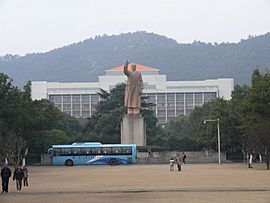
In 1966, the Cultural Revolution began, and the university stopped working normally. Students formed groups and sometimes had conflicts. In 1967, students from ZJU helped protect Lingyin Temple from being destroyed.
Recent History: 1976 to Present
After the Cultural Revolution ended in 1976, the university started to rebuild. In 1980, ZJU began to receive money from both the Ministry of Education and the Zhejiang provincial government.
In 1989, Zhejiang University students joined protests in Hangzhou to support a democracy movement. They even blocked a railway for three days.
From 1988 to 1995, Lu Yongxiang was president. He added "pursuing innovation" to the university's motto. He also improved teaching and research.
In 1995, ZJU was chosen for Project 211, another national plan for top universities. In 1998, four major universities merged to form the new Zhejiang University. This made it one of the largest higher education places in Asia.
Since 2005, the university has developed its own holding group, which now includes several public companies. ZJU has also sold some of its older campuses to help fund new developments. For example, the Hubin campus was sold in 2005.
In 2012, ZJU started the Ocean College in Zhoushan. In 2014, it partnered with the University of Edinburgh to create a joint institute. In 2015, another joint institute was formed with the University of Illinois Urbana-Champaign. A new Haining campus opened in 2016 for these international programs.
In 2020, the university opened its new Ningbo campus. It has also opened new institutes in many other cities within Zhejiang province. In 2021, a tech leader named Colin Huang donated $100 million to support a research institute at the university.
ZJU Campuses
Zhejiang University has seven campuses. These are Zijingang, Yuquan, Xixi, Huajiachi, Zhijiang, Zhoushan, and the International campus in Haining. There is also a campus in Ningbo. Together, they cover a huge area of 6.22 square kilometers.
Main Campuses Today
Zijingang Campus
Zijingang is the main campus of Zhejiang University. It is in the northwest of Hangzhou. It has two libraries and is served by the Hangzhou Metro. The South Gate of the campus is very large and was built with donations from former students. However, some students think it is not very pretty.
Many academic departments and schools are located at Zijingang Campus. These include Media, International Studies, Economics, Education, Medicine, and Engineering.
Yuquan Campus
Shaw Science Hall at Yuquan Campus was the first donation from Sir Run Run Shaw in mainland China. Yuquan campus is where engineering, computer science, and physical sciences are taught. Most students here are graduate students. Yuquan was the main campus until Zijingang was built in 2002. It is also served by the Hangzhou Metro.
The road leading to the campus is known for its beautiful trees. Nearby is Qiushi Village, where university teachers and their families live. There are also schools for younger students in the area. The Yuquan 1897 cafe on campus has an English corner every Wednesday evening.
Xixi Campus
Xixi campus used to be Hangzhou University before it joined ZJU in 1998. It now hosts departments like Psychology and Art. The campus has a large grassy area near its library. A top high school, Xuejun High School, is next to this campus. Many students from this high school go on to study at Zhejiang University.
Huajiachi Campus
The Huajiachi campus was once Zhejiang Agricultural University. It is now home to dentistry, agriculture, and continuing education programs. This is Zhejiang University's oldest campus. The campus is named after a lake within its grounds. Part of this campus was sold in 2013, and there are plans to turn it into a park while keeping its old buildings.
Zhijiang Campus
The Zhijiang campus is home to Guanghua Law School. It used to be the main campus of Hangchow University. It is located on a hill near the Qiantang River. Several buildings on this campus are protected historical sites. The 2010 movie Aftershock was filmed here, making it a popular place for tourists.
Zhoushan Campus
The Zhoushan campus opened in 2015 for the Ocean College. It is located on Zhoushan Island. The university's training ship, Zijingang, is based here. Only third and fourth-year undergraduate students and graduate students from the Ocean College study at this campus.
Haining International Campus
The Haining International Campus is in Haining. It opened in 2016 and hosts many international programs and partnerships. Students here live in a special residential college. The campus has its own library and is connected by a railway.
This campus is home to the Zhejiang University International Business School (ZIBS) and joint institutes with the University of Edinburgh and the University of Illinois Urbana-Champaign.
Ningbo Campus
The Ningbo campus started in 2017 as a partnership with the Ningbo city government. It is based at the former Ningbo Institute of Technology (NIT). While ZJU doesn't have its own library branch here, students can use NingboTech's library. The campus is also home to ZJU's School of Software Technology.
Off-Campus Research Centers
Zhejiang University also has many research centers outside its main campuses. These include centers for Artificial Intelligence in Medicine and various innovation institutes within Zhejiang province.
Outside Zhejiang, there are research centers in cities like Beijing, Shanghai, and Shenzhen.
Past Campuses
Wartime Campuses
During World War II, the university moved many times to avoid the Japanese invasion. It used temporary campuses in places like Jiande, Ji'an, Taihe, and Yishan. It finally settled in Meitan and Zunyi in Guizhou. The university operated there for seven years until the war ended.
Former Hubin Campus
The university used to have a Hubin campus. This was the former site of Zhejiang Medical University. Most of this campus was taken down in 2007. It was replaced by a modern shopping and business complex called Kerry Center.
University Identity and Culture
University Motto
In 1938, "seeking truth" (Chinese: 求是; pinyin: Qiúshì) became the university's motto. This idea comes from an old Chinese saying about learning what is right. The first academy, Qiushi Academy, was named after this idea.
In 1988, "pursuing innovation" was added to the motto. This was done to help the university adapt to new times and encourage creativity.
University Anthem
The university's anthem was written by the scholar Ma Yifu in 1938. The music was composed in 1941. In 2014, the Zhejiang University Anthem was voted the most popular university anthem in an online survey.
Mascot, Logo, and Flag
The university's mascot is the Qiushi eagle. This eagle was first seen on the university's old seal from the 1920s and 1930s. It was brought back in the university's logo in the 1990s.
The current logo of Zhejiang University was introduced in 1991. The Chinese writing in the logo comes from the calligraphy of Mao Zedong. The university's flags use a combination of this writing and the logo in blue, red, or white.
Quotes from Chu Kochen
Chu Kochen was president of Zhejiang University from 1936 to 1949. He had a big influence on the university's spirit. Two questions he asked new students in 1936 are carved in stone at the Zijingang Campus:
You have two questions to ask yourself: First, what do you want to do at Zheda? Second, when you graduate, what kind of people do you want to be?
Another famous quote from Chu Kochen talks about the goal of university education:
The aim of university education is not to nurture experts such as engineers and doctors, but to build leaders that are just, patriotic, fortitudinous and persistent, that take major roles, that lead trends, and that change the destiny of this nation.
University Organization
How the University is Run
Zhejiang University follows a special plan approved by the Ministry of Education of the People's Republic of China. It is a national university supported by both the central government and the Zhejiang government. The university is managed by its Communist Party Committee, with the president making important decisions. The leaders are chosen by a special department of the Chinese Communist Party.
Departments and Services
The university has 17 administrative departments. These departments help set goals, plan for the future, and manage international and local relationships. They also hire teachers, organize teaching and learning, and manage research programs. Other departments take care of buildings, property, and the university's hospitals.
Academic Structure
The university's subjects are divided into seven main faculties, each with different schools. Each faculty and school has its own academic committee. Zhejiang University teaches many subjects, including philosophy, literature, history, education, science, economics, law, management, engineering, agriculture, and medicine.
Faculties and Schools
- Faculty of Arts and Humanities: Includes Humanities, International Studies, Media, and Art.
- Faculty of Social Sciences: Includes Economics, Law, Education, Management, and Public Affairs.
- Faculty of Science: Combines science departments from different past universities. It includes Math, Physics, Chemistry, Earth Sciences, and Psychology.
- Faculty of Engineering: Includes Mechanical, Material Science, Energy, Electrical, Civil, Chemical, Ocean, and Aeronautics.
- Faculty of Information: Has key departments like Optical Science, Electronic Engineering, Control Science, Computer Science, and Software Technology. Computer science here is known for graphics, vision, and AI.
- Faculty of Agriculture, Life and Environment Science: Includes Life Sciences, Biosystem Engineering, Environmental Science, Agriculture, and Animal Sciences. Many subjects in this faculty are highly rated.
- Faculty of Medicine: Includes Pharmaceutical Sciences and the School of Medicine. It has seven affiliated hospitals, which are used for teaching. The medical school also offers English-taught programs.
University Finances
The university gets most of its money from the government. It is part of national plans to create world-class universities. In 2022, ZJU had the second-largest budget in China. The university also gets money from its businesses, government support, and donations.
Zhejiang University often receives large donations from its former students. In 2006, two Chinese billionaires, Duan Yongping and Ding Lei, donated 40 million US dollars. In 2017, the university received another record-breaking donation of 1.1 billion Chinese yuan (about 160 million US dollars) from alumni.
Academics at ZJU
Teaching and Learning
Academic departments are in charge of teaching and grading courses. The Undergraduate and Graduate Schools approve all degree programs. Chu Kochen Honors College (CKC), named after a former president, is a special program for top students.
To graduate, students must earn enough credits by passing required and elective courses. Students can choose their courses, but some popular ones might be hard to get into.
Qiushi College
Qiushi College started in 2008. It is a residential college that manages student dorms and offers liberal arts education for first-year students. It helps students choose their majors and get involved in activities. When students first join the university, they are part of a "hall" in Qiushi College. In their first year, students might not have a specific major yet.
Chu Kochen Honors College
Chu Kochen Honors College (CKHC) was founded in 2000. It is a very selective program for talented students. It offers different special classes, like Experimental Class of Engineering and Qiushi Sciences Class. Famous alumni from this college include entrepreneur Colin Huang. Students in this program are closely supervised, and some students might transfer out if their grades are not high enough.
International Campus Programs
The programs at the International Campus offer dual degrees with partner universities. For example, students in the joint institute with the University of Edinburgh must meet the rules of both universities. Students can choose some elective courses, but transferring between different joint institutes is usually not allowed.
Research at ZJU
Zhejiang University is a major research university. Its research covers 12 different subjects, from agriculture to philosophy.
The university has about 4,191 teachers, with over 1,893 holding the title of professor. Many of them are top experts in China. ZJU also has 11 State Key Laboratories, which are very important research centers in China. These labs focus on areas like Chemical Engineering, Optical Instrumentation, and Infectious Diseases.
The university also has other specialized labs and labs supported by the Ministry of Education.
Library System
Zhejiang University has one of China's largest academic library collections, with over 7.9 million books. It has 6 main branch libraries across its campuses, including Yuquan, Zijingang, and Xixi. There are also 3 smaller libraries within different colleges. Students can reserve books from any library in the system and pick them up at another branch.
Rankings and Reputation
| BCUR National | Domestic | 3 | |
|---|---|---|---|
| Wu Shulian National | Domestic | 2 | |
| CUAA National | Alumni | 4 | |
| QS National | General | 5 | |
| THE National | General | 5 | |
| QS Asia (Asia version) |
General | 6 | |
| THE Asia (Asia version) |
General | 9 | |
| ARWU World | Research | 33 | |
| QS World | General | =47 | |
| THE World | General | =55 | |
| USNWR World | General | =93 | |
Overall Rankings
Zhejiang University is ranked highly around the world:
- #33 in the Academic Ranking of World Universities (2023)
- #44 in QS World University Rankings (2024)
- #55 in the Times Higher Education (THE) World University Rankings (2024)
- #93 in the USNWR (2022–2023)
In 2022, ZJU was ranked #38 globally when combining results from THE, QS, and ARWU. It was also ranked #50 worldwide for its reputation by Times Higher Education.
Research Performance
- In 2021, ZJU was ranked 10th globally by SCImago Institutions Rankings.
- The 2023 CWTS Leiden Ranking placed ZJU 7th worldwide for its scientific publications.
- The Nature Index Annual Table 2023 ranked ZJU 8th globally for its scientific research output.
Subject Rankings
Essential Science Indicator (ESI)
ZJU is among the top 1% in 15 out of 22 subjects in the Essential Science Indicator (ESI) rankings. It is also in the top 100 worldwide for 4 subjects.
USNWR Subject Rankings
As of 2021, U.S. News & World Report ranked ZJU in the global Top 50 for many subjects. These include Agricultural Sciences, Chemical Engineering, Computer Science, Electrical Engineering, and Mechanical Engineering.
China's Ministry of Education Evaluation
In 2018, China's Ministry of Education ranked ZJU's subjects. ZJU had 31 subjects rated "A", which was the most among Chinese universities. 11 of these subjects received an "A+", placing ZJU third after Peking and Tsinghua universities.
| Rating | Subjects |
|---|---|
| A+ |
Ecology
|
| A |
Chinese Language and Literature
|
| A- |
Theoretical Economics
|
Graduate Job Prospects
ZJU ranked #35 worldwide in the QS Graduate Employability Rankings 2022. It was also #112 worldwide in the Times Higher Education's Global University Employability Ranking 2022. This means its graduates are highly sought after by employers.
Student Life
Student Body
In June 2023, Zhejiang University had 65,821 full-time students. This included 29,117 undergraduate students, 20,554 master's students, and 16,150 doctoral students. There were also 5,123 international students.
CC98 Forum
CC98 is an online forum run by students. It was created in December 2002. Students can visit www.cc98.org on the school's internet. It has different sections for discussing various topics. As of March 2023, the forum is only available in Chinese.
Notable People
Famous Students
See List of Zhejiang University alumni
- Li Qiang – A top political leader.
- Chen Duxiu – A co-founder and first leader of the Chinese Communist Party.
- Huang Fu – A former President and Premier of the Republic of China.
- Jiang Menglin – A former Minister of Education.
- Tsung-Dao Lee – A physicist and Nobel Prize winner (1957).
- Chien-Shiung Wu – A physicist and Wolf Prize winner (1978).
- Lu Yongxiang – A former President of the Chinese Academy of Science.
- Colin Huang – A famous entrepreneur.
- Zhu Qinan – An Olympic champion in shooting (2004 Athens).
- Zhou Suhong – A volleyball player and Olympic team champion (2004 Athens).
Famous Faculty Members
- Hailan Hu – A winner of the 2022 L'Oréal-UNESCO for Women in Science International Award.
- Shing-Tung Yau – A Fields Medal winner and director of the Center of Mathematical Sciences.
- Shiing-Shen Chern – A Wolf Prize winner.
- Chien-Shiung Wu – A Wolf Prize winner.
- Wu Wenjun – A Shaw Prize winner (2006).
- Su Buqing – A mathematician and former dean of the Department of Mathematics.
- Tan Jiazhen – A geneticist and former professor.
- Coching Chu – A meteorologist, geologist, and former president of Zhejiang University.
- Ma Yinchu – An economist and former president of Zhejiang University.
- Jin Yong – A famous novelist and former dean of the Faculty of Arts and Humanities.
- Qian Sanqiang – A physicist.
|
See also
 In Spanish: Universidad de Zhejiang para niños
In Spanish: Universidad de Zhejiang para niños
- Qiushi Academy, Hangchow University, Hangzhou University, Zhejiang Agricultural University and Zhejiang Medical University
- C9 League, Education in China, and Higher Education in China
- Taizhou Library


